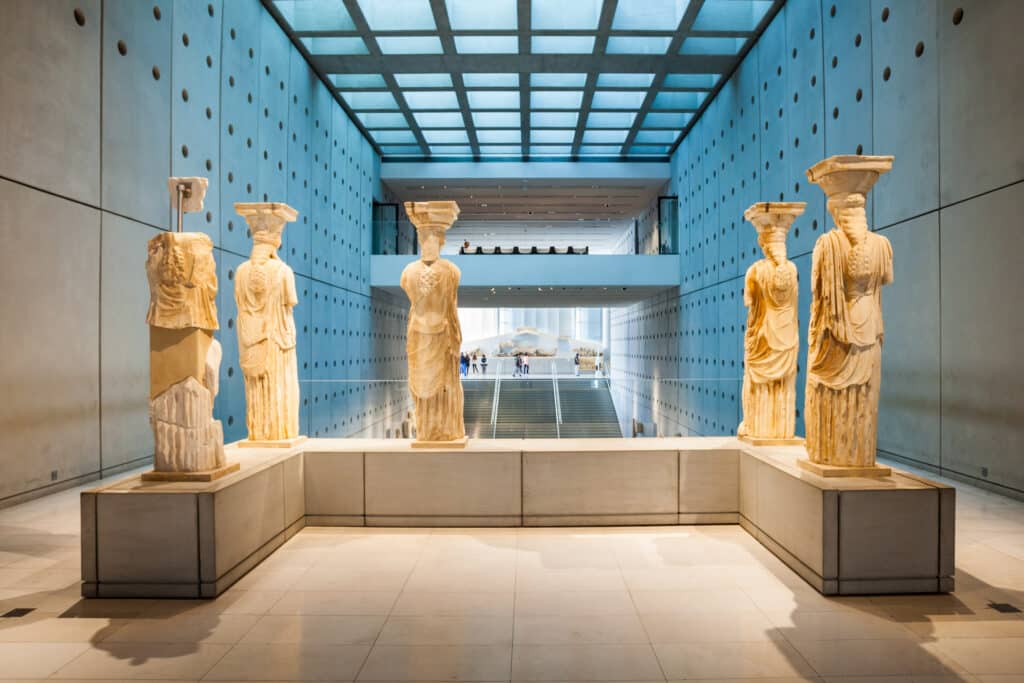
The entrance fee for the Acropolis Museum for the year 2025 is 20€ between April 1, 2025 and October 31, 2025. For students visiting from outside the European Union, as well as young people between 6 and 24 years old, the entrance fee is 10€ (but ID must be presented). Children under 5 years old can enter the Acropolis Museum free of charge.
There are also ticket types that combine the Acropolis Museum with many other important historical sites in Athens (such as the Acropolis and the Archaeological Museum). You can also book a tour of the Acropolis and the Acropolis Museum with a professional local tour guide.
The Acropolis Museum, containing one of the most valuable collections of Greek art in existence, was built in 1949-53 at the south-east corner of the Acropolis, lying so low that it does not obtrude. The rooms to the left contain material of the Archaic period (6th c. bc) that formed part of the “Persian rubble” and was recovered during excavations by Panayiotis Kavvadias in 1885-6: pediments from temples and treasuries, votive statues and (in the rooms to the right) marble figures from the pediment of the Old Temple of Athena (Rooms l-V). In the other rooms to the right (VI-XI) is sculpture of the Classical period (5th c. BC).
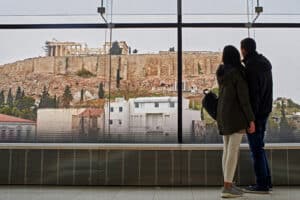
Acropolis Museum Entrance Fee, Athens
Plan of the Acropolis Museum
The Vestibule is dominated by a large owl, the emblem of Athena (early 5th c. bc). Here, too, are a marble statue of Athena, “Athena Propylaia” (end of 5th c); a marble base with a relief of soldiers dancing (4th c. bc) and a marble funerary lekythos (end of 4th a). The caryatids from the Erechtheion are temporarily housed in a room to the right.
Room I (Early 6th c. BC): to the left is a pediment group in painted poros limestone depicting Herakles fighting the Lernaean hydra (c. 600 BC). Opposite the entrance is a lioness rending a young bull, from a large poros pediment (c. 490 bc); to the right is a Gorgon (early 6th c. BC).
Room II Introduction of Herakles to Olympus (c. 580 BC). The right-hand half of the “Red Pediment”, depicting Herakles and Triton (c. 560 BC). The “Olive-tree Pediment”, probably portraying the myth of Troilos, with a representation of a temple and a girl carrying water (c. 570 BC). Two sections of a poros pediment, probably from the old Temple of Athena: to the left Harakles and Triton, to the right a three-bodied monster, now believed to be Nereus (580-570 BC). The central section of the pediment was probably the group of two lions rending a bull displayed in Room II. Here, too, are the famous Moschoporos (“Calf-Bearer”) of Hymettian marble, a votive offering by Rhombos (c. 570 BC), and the earliest of the korai, the figures of girls which were set up in large numbers on the Acropolis as votive offerings to Athena; in one hand this Attic work holds a pomegranate, in the other a garland (early 6th c. BC).
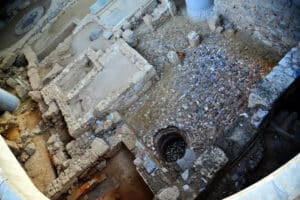
Acropolis Museum tickets
Room III: Central section of a pediment group (cf. Room II) and the torsos of two other korai, probably from Naxos or Samos (580-550 BC).
Room IV: This room contains a large number of master works. First come four or perhaps five works attributed to the same sculptor, Phaidimos. The earliest is the so-called Rampin Horseman, the head of which is a cast (original in the Louvre). Together with a second horseman preserved in fragments this formed the earliest known equestrian group in Greece. It is believed to represent either Hippias and Hipparchos, the sons of Peisistratos, or the Dioscuri (c. 550 BC).
A famous mature work by the same sculptor is the “Peplos Kore” (c. 530 BC) named after the Doric garment which she wears. A lion-head spout from the Old Temple of Athena (c. 525 BC) and a hound from the Brauronion (c. 520 BC) are also attributed to Phaidimos. A figure of a horseman in Persian or Scythian costume probably represents Miltiades (c. 520 BC).
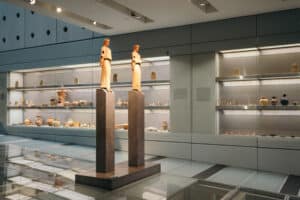
Acropolis Museum tours
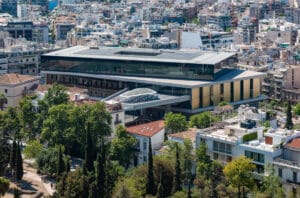
Acropolis Museum from Acropolis
In the rear part of Room IV are a group of korai, wearing the peplos or later the more elegant chiton, usually covered with the himation (cloak). As a rule one hand gathers in the maiden’s garment while the other holds a votive offering. These figures, mostly life-size, stood in the open air, and many of them still preserve the fixing of the meniskos, an iron shield designed to protect them from bird droppings. The figures were originally painted, and some traces of colouring can still be seen, particularly on the garments.
First come a kore with a serious expression, wearing Ionic costume (520-510 BC), a graceful kore from Chios in an elegantly draped painted chiton (c. 510 BC) and a very fine head (c. 510 BC).
Then, in a wide semicircle, are (from left to right) a large kore from Chios (c. 520 BC), a vigorous figure, probably from the Peloponnese (c. 490 BC), the enigmatic “Sphinx-Eyed Kore” (c. 500 BC) and a kore clad only in a chiton (c. 510 BC).
A large and badly weathered seated figure of Athena (in the centre of the group) by Endoios (c. 530 BC) is followed by the clothed figure of a youth (end of 6th c. BC), a severe kore, the only one not girding her garment (c. 500 BC), an almost unworn kore from the Ionian Islands (c. 520 BC) and a large kore, also almost undamaged (c. 520 BC).
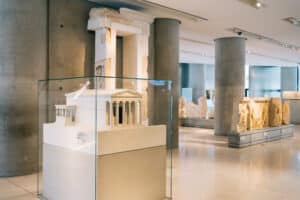
The Acropolis Museum
Room V: The most notable item is the Kore of Antenor, 2 m (6 ft) high, standing on a base bearing the name of the donor, Nearchos, and the sculptor, Antenor, which probably does not belong to it (c. 525 BC). The room is dominated by statues from the pediment of the Peisistratid Old Temple depicting Athena fighting giants (c. 525 BC). In the alcove to the left is a collection of pottery ranging in date from the Geometric to the late Classical period.
Room VI: The earliest works belonging to this first stage of classical art date from before the Persian conquest (480 BC). This room contains work of this phase together with examples of the “Severe” style.
Among outstanding items are the “Sulky Kore” (c. 490 BC), dedicated by Euthydikos; the “Kore of the Propylaia”, set up shortly before the Persian attack (c. 480 bc); a statue of Athena (480-470 bc); a relief figure of a potter (c. 500 BC); the head of a youth, from the workshop of Phidias (450-440 BC); and the forequarters of a horse, a noble work of 490-480 BC. Famous works of the early Classical period are the “Fair-Haired Youth”, a figure of unusual melancholy beauty (shortly before 480 bc); a relief of “Mourning Athena” (460-450 BC); and the oldest of the group, the figure of a boy ascribed to Kritios or his workshop (485 BC). The torso and head of this “Critian Boy” were found in 1865 and 1888. It is the earliest known figure in which the archaic posture with each leg bearing an equal weight gives place to the classical pose in which one leg bears the weight and the other hangs free. In this respect Kritios was a forerunner of the art of the Classical period.
The following rooms are devoted to the buildings of the Classical period on the Acropolis.
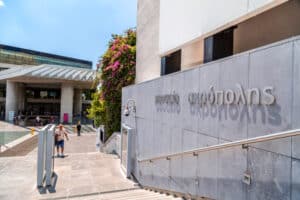
Acropolis Museum, Athens
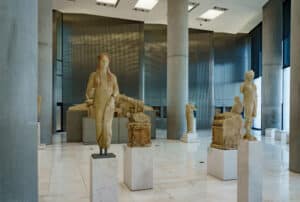
Acropolis Museum, Athens
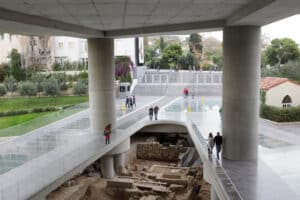
Outside of the new museum of Acropolis
Room VII: Plaster reproductions of the Parthenon pediments, a metope from the south side (centaurs and Lapiths), a torso of Poseidon from the west pediment and two horses’ heads from Poseidons team.
Room VIII: Large sections of the Parthenon frieze, 160 m (525 ft) long, depicting the great Panathenaic procession (see Agora and giving a vivid impression of life in Athens in the age of Pericles.
From the north frieze: horsemen, apobatai (who jump off and on moving chariots), marshals, musicians, youths, carrying hydrias and sacrifical animals. The last slab is undoubtedly the work of Phidias himself. From the south frieze: horsemen. From the east frieze: Poseidon, Apollo and Artemis, probably carved by Alkamenes, a pupil of Phidias.
On the projecting wall which divides the room into two are parts of the Erechtheion frieze, carved some decades after the Parthenon frieze (between 409 and 405 BC). The reconstruction shows the techniques used, the figures in light-coloured Pentelic marble being attached to the background of darker marble with metal pegs. The significance of the figures is unclear.
Finally there are a series of slabs from the parapet round the temple of Athena Nike (c. 410 BC). The reliefs, which originally decorated the outer side of the parapet, depict a seated Athena with a number of goddesses of victory, including the famous Nike losing her sandal.
Room IX: A large mask of a deity, a bas-relief of an Attic trireme and – the most notable item – an idealised portrait of the young Alexander, probably carved by Leochares or Euphranor after Alexander’s visit to Athens in 335 BC. Also very beautiful is the marble group “Procne and Itys” by Alkamenes.

